ABSTRACT
Railway sahayak or also known as coolie is one of the oldest occupations in India. This occupational group is continuously subjected to various musculoskeletal problems due to repetitive load exertion in unnatural postures. The present research aims to examine the prevalence of musculoskeletal disorders (MSDs) among Indian railway sahayaks. A cross-sectional study has been conducted on a sample of 51 male sahayaks. With a modified Nordic questionnaire, data were collected on their demographics, work, and musculoskeletal pain history. Electromyography (EMG) of the upper trapezius muscle of selected 12 healthy sahayaks having no history of neck–shoulder complaints were analyzed under different load lifting and carrying conditions. Additionally, ergonomic risk levels were recorded using Rapid Entire Body Assessment method. The questionnaire revealed that for the past 1 year prevalence, the most affected body regions of railway sahayaks were neck (47%), shoulder (51%), lower back (43%), and knee (47%). The association between age group and MSDs in different body regions were found significant (p = 0.012 for neck, p = 0.017 for shoulder, etc.). Work experience also had a significant relation to the MSDs in different body regions (p = 0.013 for shoulder,p = 0.023 for calf, etc.). Analysis of variance reveals high significance level between EMG values and tasks performed by the sahayaks. In conclusion, railway sahayaks were found to have high rate of MSDs which may be associated with lifting/carrying heavy loads in awkward postures. Ergonomic interventions must be implemented to reduce the risk level on this group of workers.
KEYWORDS: Musculoskeletal disorders, railway sahayaks, ANOVA, EMG, posture analysis
Introduction
Musculoskeletal disorders (MSDs) associated to work consists of conditions such as pain, inflammation, tingling, and numbness involving tendons, muscles, nerves, cartilage, ligaments, and joints. Often associated to or aggravated by the work, these disorders or injuries are termed as work-related musculoskeletal disorders (WMSDs) [1]. This category of MSDs takes months or sometimes even years to develop and affect workers in a wide range of occupations [2]. These are the reasons of worker’s absenteeism, disability, health-care costs, and compensation claims [2]. Some of the common MSDs are low back pain, cervical spondylosis, and osteoarthritis. Such disorders cost about 23% of the total illness cost [3].
Despite the fact that countries around the world nowadays prefer mechanization in the industries, workers in these industries still have to carry out manual material handling task to earn a livelihood. The most important risk factors attributed with such tasks consists of (a) repetitive motions (frequent lifting/carrying of loads), (b) forceful exertions (lifting/carrying of heavy loads), (c) awkward postures (bending/twisting), (d) accumulated pressure points with loads having sharp edges, and (e) static postures for long duration [4]. Repeated or continuous exposure to any of these risk factors may result in discomfort and fatigue initially [5]. The risk level generally depends on the duration of exposure of a worker, the frequency of exposure to risk factors, and the intensity of the exposure [1]. With time, the workers are susceptible to injuries in neck, shoulders, back, wrists, hands, or other body parts [6].
Repetitive lifting at high exertive force is a major cause of low back injuries [7]. Generally, back pain affects about 75–80% of the population and frequently causes activity limitation in people younger than 45 years [8,9]. Numerous studies carried out in the past revealed a strong relation between work-related tasks demanding forceful arm efforts and the rate of neck disorders [10,11]. Irrespective of this, work-related pain in shoulder occurs frequently in many occupations requiring heavy muscular load, such as construction workers [12], platers [13], and welders [14]. The risk of rotator cuff tendinitis in occupations requiring use of hands at or above shoulder level is more in comparison to the general workers [15].
Association between demographic characteristics and MSDs among various workers had been conducted by past researchers [16–18]. The most common tool used for studying the prevalence of MSD problems in any occupational field is the standardized Nordic questionnaire [19]. It can easily be employed in interviews or self-administered interviews, and is suitable for investigating historical musculoskeletal problems in occupational people. One thing worth mentioning is its dependence on the recall memory of the study population as it requires symptoms and problems experienced during the past 12 months.
Electromyography (EMG) has also been widely used over the past 50 years to gain insight into how neural or muscular control strategies adapt to the task requirements of an individual [20]. An electromyographic activity is a neuromuscular response to biomechanical activity. The most widely used method to get the reference value of muscle activation for normalizing EMG signals has been the use of maximum voluntary isometric contraction [21–23]. During isometric contractions, a well-defined relationship exists between the magnitude of voluntary muscle activity and the EMG signal amplitude [24]. In occupational workers with neck–shoulder complaints, there was an increase in electromyographic activity of the shoulder muscles while performing work-related tasks [25–28].
Rapid entire body assessment (REBA) is one of the widely known ergonomic tool used to analyze the posture adopted by employees during their work [29]. It is done by assigning specific score to different body postures and then comparing it with REBA generalized score to find the current risk level.
In Indian railways, sahayaks are directly involved in heavy physical activity and strenuous work. Such activities include frequent lifting of heavy weight above shoulder height, pushing, carrying, and lowering of weights while adopting unnatural postures (twisting and bending). Such situations may lead to WMSDs in different body regions. In a study over mill sahayaks lifting loads on head, it was found that about 39.8% have a risk of cervical spondylosis in which more than half (51.3%) of the cases were in participants younger than 40 years [30]. There are approximately 20,000 sahayaks working on the stations under the Indian Railways [31]. They come under the unorganized sector of workers.
To the best of our knowledge, no research has been conducted on the health situation of the railway sahayaks at any workplace in India, and either few or none have been carried out to examine the prevalence of musculoskeletal problems. The current research work was planned and carried out at the railway station of Rourkela city in India to assess the prevalence of MSD symptoms among the sahayaks and to analyze the associated risk factors. The result of this study is believed to help in planning and implementing ergonomic intervention programs to improve sahayaks’ health.
Methods
Study population
For this study, licensed sahayaks under Commercial Department, Chakradharpur Division working at Rourkela railway station were selected as they are bound to work only on the station i.e. one job. Under Rourkela railways, there were 72 male licensed sahayaks working on the station. A random sample of 51 sahayaks were selected for this cross-sectional study subject to their availability and acceptance to take part in the study. The timing of the study was planned according to the leisure period of sahayaks (during no train rush) without obstructing their work. All sahayaks in the age range of 21–76 years (mean 36.44, median 34, SD 11.45) who participated in this study had at least 1 year of work experience in this profession since questionnaire was based on past 12 months recall period, except for 4 participants who were asked to provide symptom details related to this occupation only. The study design flow diagram is shown in Figure 1.
Figure 1.
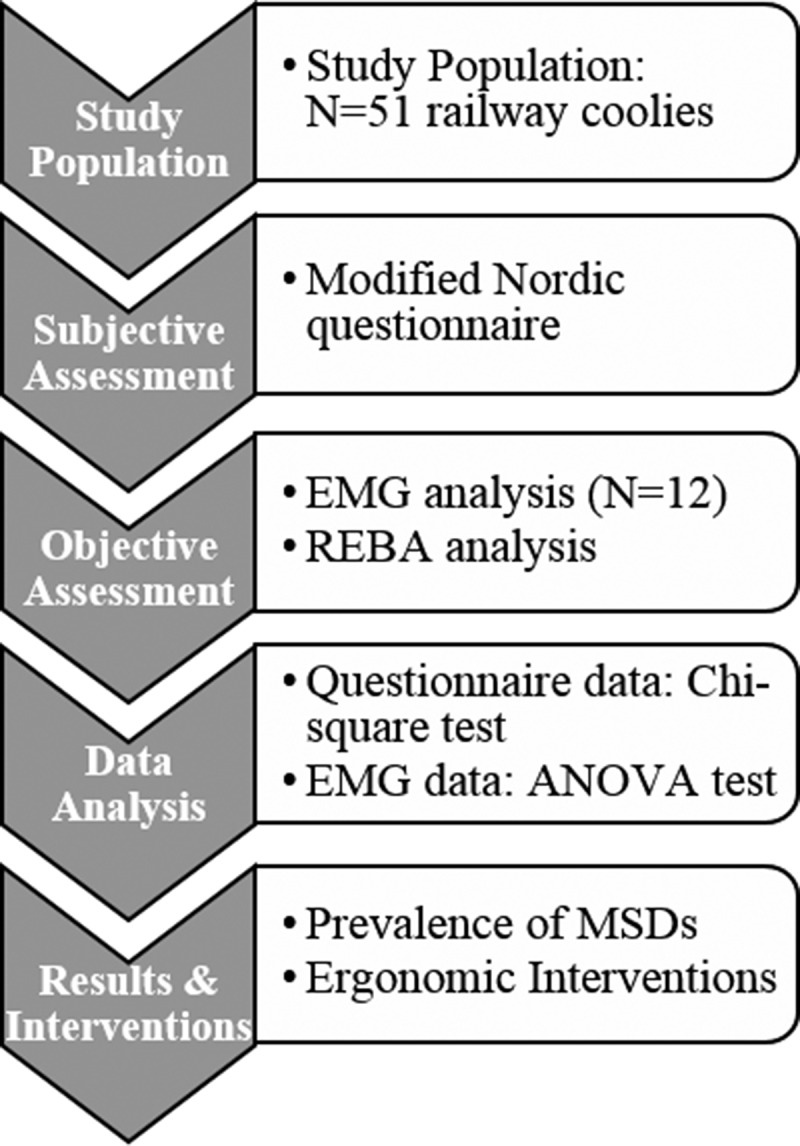
Schematic representation of study design.
The anthropometry data (weight and height) of the selected participants were scaled by the weighing and the height measuring instrument, respectively. The body mass index (BMI) was also calculated for all the responders. The study design was discussed with the authority at South Eastern Railways, Chakradharpur Division (zone responsible for Rourkela Railways) prior to the study. The research was approved by the Institute Ethical Committee. Before starting the survey, the study design/protocol was explained to each of the participants and were asked to sign an informed consent sheet.
Questionnaire study
The information was collected by a modified Nordic questionnaire through self-administered interview. The medium of the questionnaire was English. It was verbally translated into local language during the interview. The questionnaire comprises of multiple answer-type objective questions that involved detailed information on the candidates’ demographic characteristics, data on manual load handling, preferred body part to carry/lift load, general health issues, and musculoskeletal problems in specific body parts like neck, upper back, lower back, shoulders, knees, and calfs. For a station sahayak, there are no fixed daily working hours, because it depends on the train rush hour. Therefore, they were questioned about the average frequency of luggage handling per day. Musculoskeletal complaint was defined to them as any discomfort or pain they experienced in their body parts, which had occurred for at least 1 or 2 working days during the past 1 year. The medical history and the filling of questionnaire were administered by the research team. The study took 8 days to complete.
Experimental task
The task for experimentation was designed after observing the real work scenario of railway sahayaks. Tasks of lifting and carrying loads on head, hands, and in both simultaneously were performed on straight line (task 1) and staircase (task 2) tracks for a defined distance at the railway platform. Figures 2 and 3 represent the pictorial sequence of experimental tasks. Three different load criteria: (a) 20 kg on head, (b) 10 kg each in both hands, and (c) 20 kg on head with 10 kg in dominant hand were considered. Pre-weighed loads in the form of luggage and hand bags were made available. For both the tasks, a total of 6 trials were recorded for each participant. These tasks were designed for low physical demand and fatigue in order to prevent unexpected injury.
Figure 2.
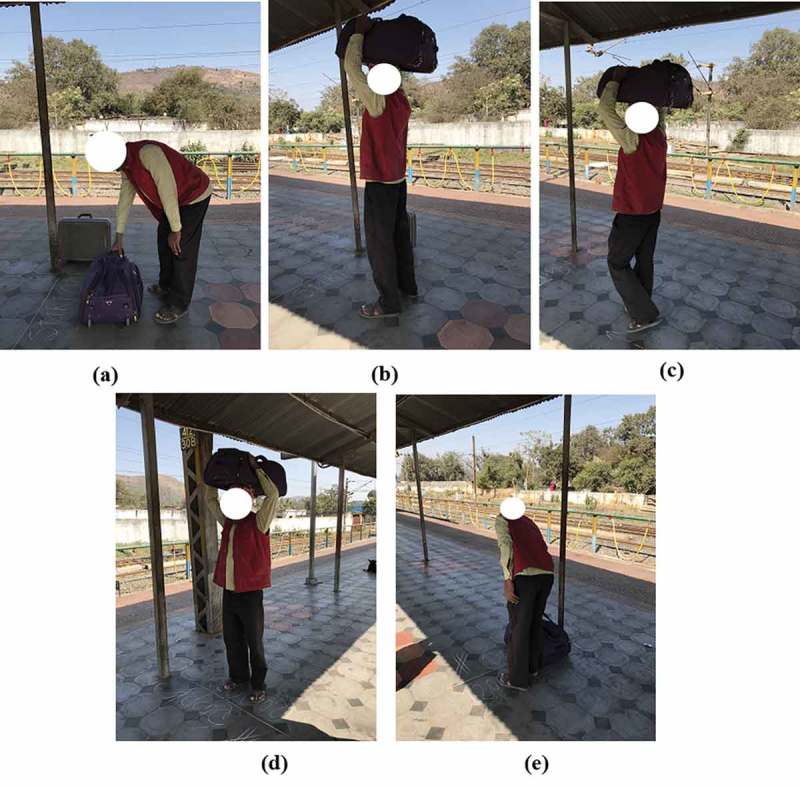
Pictorial sequence of task 1 (straight path): (a) Pick up a load; (b) Put it on desired body part; (c) Carry it over a distance of 20 m; (d) Stop; (e) Put it down.
Figure 3.
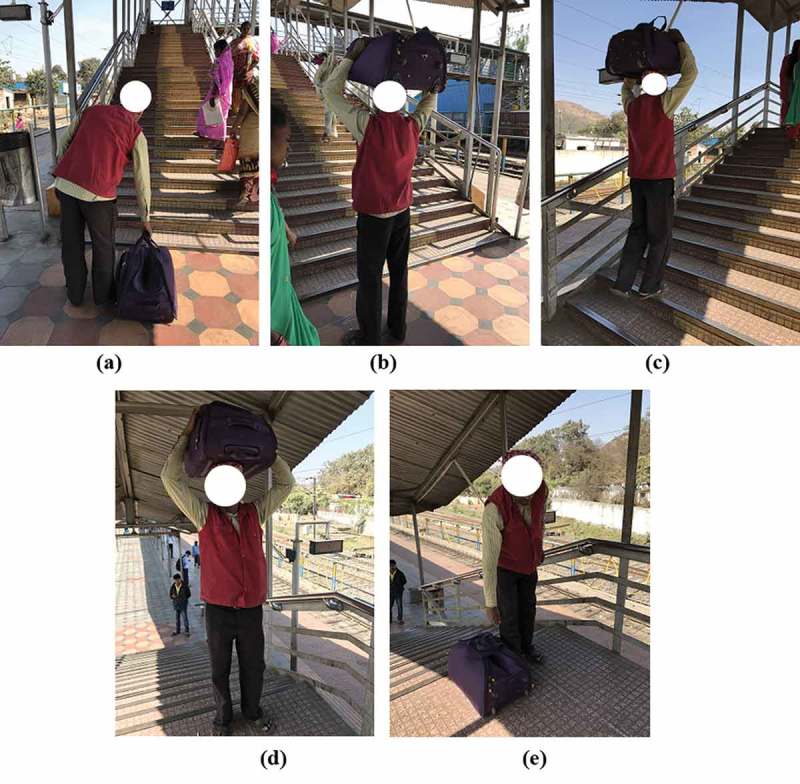
Pictorial sequence of task 2 (staircase path): (a) Pick up a load; (b) Put it on desired body part; (c) Carry it while climbing 16 steps; (d) Stop; (e) Put it down.
Electromyography
EMG data were recorded for 12 sahayaks lifting and carrying luggages as per the designed tasks. The participants in the sample size had no history of neck–shoulder complaints. The upper Trapezius muscle of shoulder of the dominant hand was assessed through EMG while performing tasks. Trained research scholars were utilized to perform the EMG recordings. For all the sahayaks, the dominat hand was the most preferred choice to pick the luggage. The reason behind the selection of this particular muscle was its association to the neck–shoulder pain, its responsiveness to stress [27,32], and its superficial position, which make it easy to perform surface EMG. An in-lab constructed single-channel EMG biopotential amplifier has been utilized for the recordings [33]. Proper care has been taken to make the participant familiar with the equipment before the starting of experiment. The desired muscle site was prepared by abrading the skin and cleaning the area with alcohol. Following the cleaning, the bipolar surface EMG electrodes were positioned on the upper trapezius muscle in line with the spinous process C7 to the acromion process [34]. The electrodes were placed at a distance of 20 mm (Ag-AgCl electrodes, Easytrode, Coimbatore, India). The reference electrode was positioned over spinous process C7.
For normalizing purpose, bilateral 90° arm abduction was performed three times to produce voluntary isometric contractions while EMG activity was recorded [35].The participants were asked to produce maximum possible force and hold it for minimum 2–3 s. The maximum voluntary contraction (MVC) was calculated as the highest mean RMS value obtained with 1 sec window moving in 100 ms steps [36]. The raw EMG signals were band-limited to 28–742 Hz. The signals were amplified 1150 times and sampled at 1000 Hz. During the recordings, the signal quality was inspected visually before initiating the measurements and in between. When excessive noise was present, the skin was recleaned and the electrodes were changed, so that good quality signal can be obtained. The signals were acquired in a laptop using a 14-bit data acquisition module (USB 4704-AE, Advantech, Taipei, Taiwan). The acquired EMG signals were processed using a laboratory developed LabVIEW (13.0, National Instruments, Austin, TX, USA) program. The study took 7 days to complete wherein EMG data were recorded for a maximum of two participants each and every day.
Posture analysis
REBA method was implemented for the analysis of various body postures adopted by railway sahayaks during their work. It was proposed that REBA method can be used as a means to analyze posture whose continuous adoption may lead to WMSDs [29]. In this method, the most frequent postures adopted by sahayaks during their work were considered and scores were calculated to assess the risk level of concerned postures. To assign scores, stick diagrams were drawn using photographic records of sahayaks during their work.
Data evaluation
The data collected through questionnaires were finally edited and evaluated. IBM SPSS tool 24.0 was used to statistically analyze the collected data. Chi-square test was performed to study the associations between age, body mass index, duration of occupation, and musculoskeletal symptoms of railway sahayaks. The adopted significance level was p < 0.05.
EMG readings recorded during the experiments were also analyzed. The MVC was calculated by taking mean of the RMS value obtained during maximum voluntary isometric contraction activity with 1 sec window moving in 100 ms steps. The EMG data obtained during the experiment were first converted into RMS value by taking 100 ms window. The RMS value was then divided by the maximum contraction value. This gave us the values in %MVC. These %MVC values were then added for each and every task to get a whole value. This was done for each participant’s recorded data. In the end, we had 72% MVC values. The experiment was a two-factor (3 × 2) design. These factors were the loads and the tracks, respectively. Here, two-way Analysis of Variance (ANOVA) for EMG (%MVC), loads, and tracks was conducted to analyze the effect of latter two on first. IBM SPSS tool was used to perform ANOVA. The adopted significance level was p < 0.05.
Results
This study reports on the prevalence of MSDs in railway sahayaks of population sample size of 51. The selected respondents were male with 72% of them below 40 years of age. More than 90% of them prefer to lift load on their head. Musculoskeletal prevalence was found in 33 out of 51 sahayaks (65%). No musculoskeletal symptoms were reported in 18 out of 51 sahayaks (35%). Table 1 summarizes the demographic characteristics of the railway sahayaks who participated in this study.
Table 1.
Demographic characteristics of railway sahayaks (N = 51).
| Variable | Number | Percentage |
|---|---|---|
| Age group in years | ||
| 21–30 | 25 | 25% |
| 31–40 | 24 | 47% |
| 41–50 | 8 | 16% |
| >50 | 6 | 12% |
| BMI (kg/m2) | ||
| <18.5 | 15 | 29% |
| 18.5–24.9 | 31 | 61% |
| 25–29.9 | 5 | 10% |
| Literacy level | ||
| Illiterate | 6 | 12% |
| Primary school | 21 | 41% |
| High school | 23 | 45% |
| Degree | 1 | 2% |
| Years in work | ||
| <1 | 4 | 8% |
| 1–5 | 23 | 45% |
| 5–10 | 19 | 37% |
| >10 | 5 | 10% |
Table 2 represents the prevalence of MSDs in different body parts of the sahayaks during the past 1 year. The primary affected body parts were lower back (43%), neck (47%), shoulders (51%), upper back (27%), thighs/hips (26%), and knees (47%). Two interesting findings were ankle/feet (35%) and calfs (31%). Figure 4 represents the prevalence of musculoskeletal symptoms reported by railway sahayaks in different body regions according to the age group. Two out of 13 (15%) sahayaks in the age group 21–30 years had suffered from neck disorder. It was found that, with an increase in age, the prevalence of musculoskeletal symptoms goes on increasing, i.e. 12 out of 24 (50%) responders in age group 31–40 years, 6 out of 8 (75%) in 41–50 years, and 5 out of 6 (83%) in >50 years age group had neck disorders in the past 1 year. Similarly, prevalence increased in other body parts with an increase in age (Figure 4).
Table 2.
Prevalence of MSDs in various body parts during the past 1 year.
| Body Regions | Frequency | Percentage (%) |
|---|---|---|
| Neck | 24 | 47% |
| Shoulder | 26 | 51% |
| Elbow | 6 | 12% |
| Wrist/Hand | 4 | 8% |
| Upper Back | 14 | 27% |
| Lower Back | 22 | 43% |
| Thigh/Hip | 13 | 26% |
| Knee | 24 | 47% |
| Ankle/Foot | 18 | 35% |
| Calf | 16 | 31% |
Figure 4.
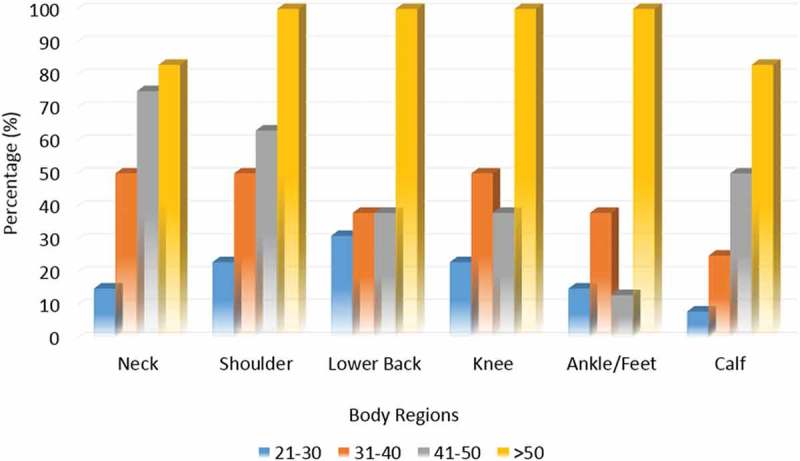
Prevalence of MSDs reported by railway sahayaks as per the age group.
Figure 5 shows the distribution of railway sahayaks with musculoskeletal symptoms in various body parts according to their work experience. Two out of 4 (50%) sahayaks in the work group of less than 1 year had suffered from neck disorder. With an increase in experience, the prevalence also goes on increasing, i.e. 8 out of 23 (35%) in experience group 1–5 years, 12 out of 19 (63%) in group 6–10 years, and 4 out of 5 (80%) in the group >10 years had neck disorders in the past 1 year. One interesting fact was found that 10 out of 16 (62.5%) cases of calf pain were reported in the group 1–5 years.
Figure 5.
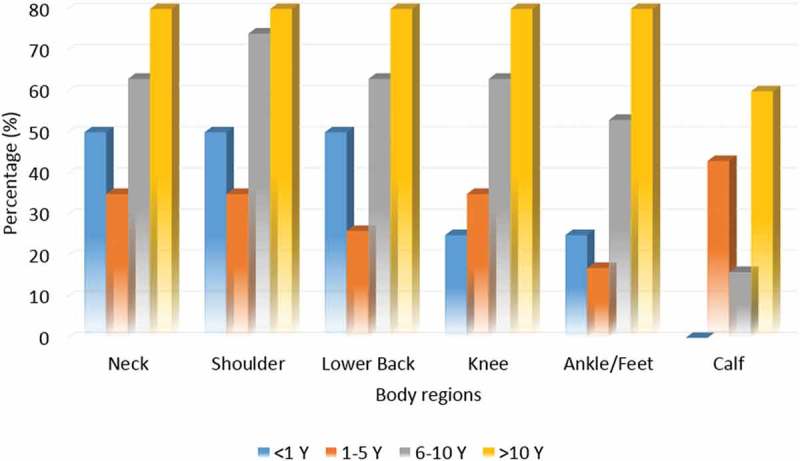
Prevalence of MSDs reported by railway sahayaks as per the work experience.
Table 3 shows the association between age, body mass index, and work experience with musculoskeletal prevalence in various body parts. A significant association between age and work tenure with musculoskeletal symptoms in various body parts was found. The body mass index had no any significant association with musculoskeletal symptoms in various body parts except for neck which had a significance of 0.009, well below than our adopted significance level of 0.05.
Table 3.
Association between demographic factors and musculoskeletal problems in various body parts (p value).
| Demographic factors | Body regions |
|||||
|---|---|---|---|---|---|---|
| Neck | Shoulder | Lower back | Knee | Ankle/Feet | Calf | |
| Age | 0.012 | 0.017 | 0.028 | 0.018 | 0.002 | 0.005 |
| BMI | 0.009 | 0.424 | 0.311 | 0.205 | 0.472 | 0.089 |
| Work experience | 0.026 | 0.013 | 0.018 | 0.045 | 0.015 | 0.023 |
Table 4 represents ANOVA evaluation results for EMG (%MVC) data recorded for the designed parameters (various loads and tracks). The load had significant effect on EMG (%MVC) for upper trapezius muscle having p value almost equal to 0 (0.000). The track also had a significant effect on EMG (%MVC) having p value almost equal to 0 (0.001). The combined effect of both load and track on EMG (%MVC) for upper trapezius muscle was found insignificant (p = 0.789). Table 5 represents mean %MVC values of the upper Trapezius muscle obtained while performing experimental tasks. The highest mean %MVC value (53.06) was found while carrying 20 kg load on the head with another 10 kg in the dominant hand and climbing the staircase. The lowest mean %MVC value (38.9) was found while carrying 10 kg loads in each hand and walking on straight track.
Table 4.
ANOVA for EMG (%MVC) recordings on experimental tasks.
| Source | Sum of Squares | df | Mean of Squares | F | Significance (p value) |
|---|---|---|---|---|---|
| Load | 146,572,530.80 | 2 | 73,286,265.41 | 20.877 | 0.000 |
| Track | 41,998,719.43 | 1 | 41,998,719.43 | 11.964 | 0.001 |
| Load*Track | 1,669,100.741 | 2 | 834,550.371 | 0.238 | 0.789 |
Table 5.
Mean %MVC values of upper trapezius muscle for experimental tasks (N = 12).
| Load Type | Track Type |
|
|---|---|---|
| Straight | Stair | |
| 20 kg (on head) | 41.2 | 50.8 |
| 10 kg (each in both hands) | 38.9 | 47.45 |
| 20 kg (on head) + 10kg (in dominant hand) | 46.42 | 53.06 |
Table 6 depicts the working posture analysis of railway sahayaks using REBA method. Results in terms of REBA scores acquired for body postures frequently adopted during work are compared to pre-defined risk levels [29]. The scores obtained comes in the level of 8–10, which is under the category of high risk and thus immediate corrective actions are desired. Prolonged adoption of such poor postures may lead to musculoskeletal complaints.
Table 6.
Work posture analysis of railway sahayaks using REBA technique.
| Activity details | Posture | REBA score | Risk level | Action |
|---|---|---|---|---|
| Picking up of load |  |
10 | High | Necessary soon |
| Carrying load on head | 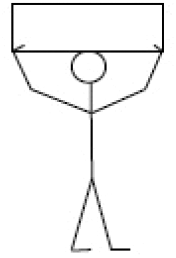 |
8 | High | Necessary soon |
| Putting load on the ground |  |
10 | High | Necessary soon |
| Carrying load on stairs | 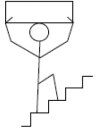 |
9 | High | Necessary soon |
| Putting load under the seats | 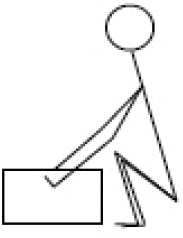 |
10 | High | Necessary soon |
| Load stacking on head | 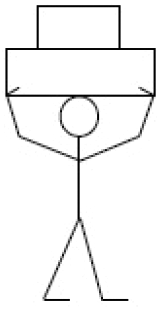 |
8 | High | Necessary soon |
Questionnaire studies (Figure 6) represent that apart from MSDs, most of the sahayaks also suffered from gastrointestinal problems (49%), 15 out of 51 (29%) suffered from cardiovascular disease, and 8 (16%) suffered from respiratory problems (shortness of breath and asthma).
Figure 6.
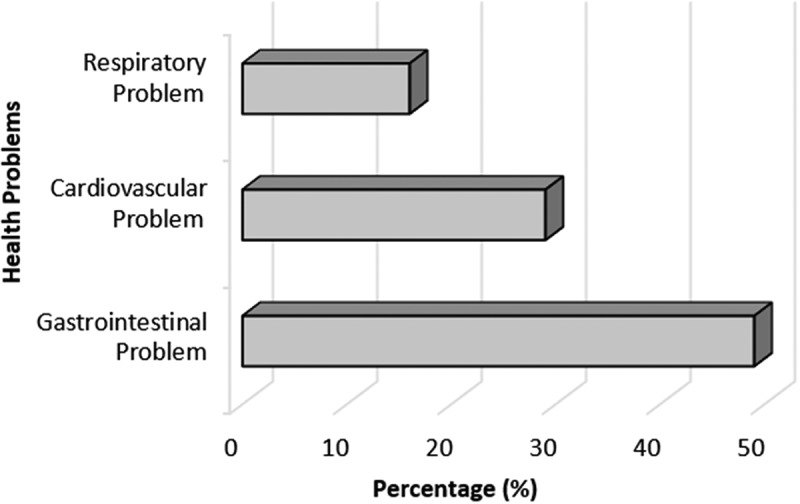
Health problems in sahayaks according to questionnaire study (N = 51).
Discussion
In India, the health issues of the workers working in various unorganized sectors are given less importance. Very limited provision exists for occupational health services in such sectors. Sahayaks are mostly male and belongs to a low socioeconomic class. They have to carry out tough physical tasks while working in a hazardous and unhealthy environments. Despite the fact that they stay long at the station working, their earning is very low. The present study aimed to represent the problem of WMSDs among railway station sahayaks in India. The study also focuses on the EMG analysis of the upper trapezius muscle to get an overview of how a shoulder muscle of a railway sahayak reacts when subjected to load lifting/carrying during their work. In developed countries, it is not common to carry heavy loads/luggages on shoulders and head.
The research revealed that a considerable proportion (65%) of the railway sahayaks in Rourkela suffered from musculoskeletal problems, the reason may be the nature of their occupation. Various organizations around the world have performed investigative studies on the possible effects of manual material handling on different body parts, but no such study had been conducted on railway sahayaks in India before, resulting in a lack of data on prevalence of work-related musculoskeletal symptoms. It was found that major affected body regions were neck (47%), shoulder (51%), lower back (43%), and knee (47%). The outcomes of this study were found to be in good agreement with findings of other authors/scholars on manual material handling and WMSDs [16,30]. However, any difference is possibly due to the reason that the number of respondents in our case was low.
The results of this study present a strong relation between manual load lifting/carrying and the prevalence of musculoskeletal symptoms in various body parts. Results suggest that in comparison to general workers, railway sahayaks are subjected to a higher rate of MSDs. One of the main reasons of pain in the upper part of the body is lifting and carrying of heavy loads above shoulder height [37]. The lifting guidelines recommended by the National Institute of Occupational Safety and Health (NIOSH), USA, suggest 23 kg as the maximum load for the entire working population [38]. The recommended weight limit is to be reduced by multipliers depending on the distance of the load from the body, its vertical height, body twisting, and the grasping strength. Nevertheless, in no condition, the weight should exceed 23 kg.
Data on the EMG analysis of load/luggage carriers are limited, hence no direct comparison can be made. Muscular discomfort is the pain arising from effort and postures involved [39]. But, higher significance level shows that there is an increase in muscle activity of the upper trapezius muscle of the sahayaks when carrying out manual material handling tasks. The higher levels of %MVC value were evidence of the risk factors involved in the work activities of Indian railway sahayaks. It seems logical that the shoulder abduction while carrying 20 kg load on the head produced higher %MVC values in comparison to the straight hand carrying a 10 kg load because of bad posture and higher load. This study tells us, with an increase in load/weight, there is an increase in muscle activity and bad posture also influences the output of EMG analysis.
The study evidently revealed that a major proportion of railway sahayaks were suffering from musculoskeletal problems in different body regions. In addition to this, sahayaks have to face some other problems like cardiovascular, respiratory, and gastrointestinal problems. Results of the current research must be interpreted according to the limitations of this study. The place of study was selected as per the convenience, so occurrence of MSDs in railway sahayaks cannot be generalized. The study was conducted only on the current working sahayaks and due to lack of past data, the prevalence of musculoskeletal symptoms in this occupational group may not be completely estimated.
Conclusion
After observing and analyzing the results, it can be concluded that the railway sahayaks are subjected to a high rate of MSDs. The practice of carrying heavy loads and adoption of awkward postures may be the reason behind this prevalence. The primary affected body regions are neck, lower back, shoulder, knee, and ankle/feet. The EMG (%MVC) results confirmed that with an increase in load, there was an equivalent increase in muscle activity. Consequently, it can cause fatigue in sahayaks after carrying out such tasks [40,41]. The normal physical activity of the sahayaks can get affected due to their working conditions and a possible consequence may be the development of serious MSDs in long run. The REBA scores also revealed that postures adopted were at high risk level and need immediate ergonomic interventions to improve work-related postures. Apart from highlighting the plight of the sahayaks, few design interventions should be emphasized, like automated hook system to transfer luggage from one station to another, innovative body armor to distribute loads on other body parts instead of only head and shoulder, etc. Further study should be performed on a larger population based on sahayaks working in different regions of India in order to find out a more generalized trend of MSDs for implementation of necessary preventive measures. A detailed and more comprehensive study can also be performed over other sectors where similar or different lifting techniques are employed to gain a more generalized results. Multi-channel sophisticated EMG device should be used to assess other neck–shoulder muscles apart from upper trapezius muscle.
Ergonomic interventions
Given below are some suggestions or immediate ergonomic interventions which must be implemented in order to reduce risk level and consequently, occurrence of MSDs in railway sahayaks:
Manual material handling limit on railway stations must follow NIOSH recommended material handling model.
Job rotation should be followed to reduce strain level.
Mechanical trolleys should be used to move loads above 23 kg.
Sahayaks should perform stretching exercise before starting work in the morning.
Proper ergonomic program should be held by Indian Railways every year to make sahayaks familiar with good postures during work.
Proper physical training/yoga programs should be held for railway sahayaks to encourage/enlighten them to adopt a healthy work life.
Acknowledgments
The authors sincerely thank Shri. Bhaskar, Sr. Divisional Commercial Manager, South Eastern Railway, Chakradharpur, for allowing us to carry out our research study in Rourkela railway station premises. The authors appreciate the help of Prof. Kunal Pal and his team, Department of Bio-Medical and Bio-Technology Engineering at National Institute of Technology, Rourkela, in fabricating the EMG device. The authors also thank all the coolies for their cooperation in the study.
Disclosure statement
No potential conflict of interest was reported by the authors.
References
- [1].Lei L, Dempsey PG, Xu J-G, et al. Risk factors for the prevalence of musculoskeletal disorders among Chinese foundry workers. Int J Ind Ergon. 2005;35:197–204. [Google Scholar]
- [2].Hagberg M, Silverstein B, Wells R, et al. Work related musculoskeletal disorders (WMSDs): a reference book for prevention. London: Taylor & Francis; 1995. [Google Scholar]
- [3].Jacobson L, Lindgren B, Sjukdomarna VK.. What are the cost of illness? Stockholm: Socialtyrelsen (National Board of Health & Welfare); 1996. [Google Scholar]
- [4].Rossi D, Bertoloni E, Fenaroli M, et al. A multi-criteria ergonomic and performance methodology for evaluating alternatives in “manuable” material handling. Int J Ind Ergon. 2013;43:314–327. [Google Scholar]
- [5].Van der Beek AJ, Hoozemens MJM, Frings-Drasen MHW, et al. Assessment of exposure to pushing & pulling in epidemiological field studies: an overview of methods, exposure measures, and measurement strategies. Int J Ind Ergon. 1999;24(4):417–429. [Google Scholar]
- [6].Ergonomic Guidelines for Manual Material Handling National institute for occupational safety and health. Cincinnati: DHHS (NIOSH) Publication No. 2007-131; 2007.
- [7].Resnick M, Chaffin DB.. An ergonomic evaluation of three classes of material handling device (MHD). Int J Ind Ergon. 1997;19(3):217–229. [Google Scholar]
- [8].Kelsey JL, Pastides M, Bisbee GE. Musculoskeletal disorders. New York: Prodist; 1978. [Google Scholar]
- [9].Frymoyer JW, Cats-Caril WL. An overview of the incidence and costs of low back pain. Orthop Clin America. 1991;22:263–271. [PubMed] [Google Scholar]
- [10].Malchaire J, Cock N, Vergracht S. Review of the factors associated with musculoskeletal problems in epidemiological studies. Int Arch Occup Environ Health. 2001;74:79–90. [DOI] [PubMed] [Google Scholar]
- [11].Walker-Bone L, Cooper C. Hard work never hurt anyone: or did it? A review of occupational associations with soft tissue musculoskeletal disorders of the neck and upper limb. Annuals Rheum Dis. 2005;64:1391–1396. [DOI] [PMC free article] [PubMed] [Google Scholar] [Retracted]
- [12].Bjelle A, Hagberg M, Michaelsson G. Occupational and individual factors in acute shoulder-neck disorders among industrial workers. Br J Ind Med. 1981;38:356–363. [DOI] [PMC free article] [PubMed] [Google Scholar]
- [13].Herberts P, Kadefors R, Högfors C, et al. Shoulder pain and heavy manual labor. Clin Orthop Relat Res. 1984;191:166–178. [PubMed] [Google Scholar]
- [14].Stenlund B, Goldie I, Hagberg M, et al. Shoulder tendinitis and its relation to heavy manual work and exposure to vibration. Scandivanian Journal of Work, Environment and Health. 1993;19:43–49. [DOI] [PubMed] [Google Scholar]
- [15].Hagberg M, Wegman DH. Prevalence rates and odds ratios of shoulder neck diseases in different occupational groups. Br J Ind Med. 1987;44:602–610. [DOI] [PMC free article] [PubMed] [Google Scholar]
- [16].Joshi TK, Menon KK, Kishore J. Musculoskeletal disorders in industrial workers of Delhi. Int J Occup Environ Health. 2001;7(3):217–221. [DOI] [PubMed] [Google Scholar]
- [17].Choobineh A, Tabatabaei SH, Mokhtarzadeh A, et al. Musculoskeletal problems among workers of an Iranian rubber factory. J Occup Health. 2007;49:418–423. [DOI] [PubMed] [Google Scholar]
- [18].Das B. Prevalence of work-related musculoskeletal disorders among the brick field workers of West Bengal, India. Arch Environ Occup Health. 2014;69(4):231–240. [DOI] [PubMed] [Google Scholar]
- [19].Kourinka I, Jonsson B, Kilbom A, et al. Standardized Nordic Questionnaires for the analysis of musculoskeletal symptoms. Appl Ergon. 1987;18:233–237. [DOI] [PubMed] [Google Scholar]
- [20].Rouffet DM, Hautier CA. EMG normalization to study muscle activation in cycling. J Electromyogr Kinesiol. 2008;18:866–878. [DOI] [PubMed] [Google Scholar]
- [21].Szeto GPY, Straker LM, O’Sullivan PB. A comparison of symptomatic and asymptomatic office workers performing monotonous keyboard work-1: neck and shoulder muscle recruitment patterns. Man Ther. 2005;10:270–280. [DOI] [PubMed] [Google Scholar]
- [22].Mork PJ, Westgaard RH. Back posture and low back muscle activity in female computer workers: a field study. Clin Biomech. 2009;24:169–175. [DOI] [PubMed] [Google Scholar]
- [23].Chaikumarn M, Nakphet N, Janwantanakul P. Repeatability of EMG normalization of the neck and shoulder muscles in symptomatic office workers. Int J Occup Saf Ergon. 2018;24(3);422–430. [DOI] [PubMed] [Google Scholar]
- [24].Inman VT, Ralston HJ, De Saunders CM, et al. Relation of human electromyogram to muscular tension. Electroencephalogr Clin Neurophysiol. 1952;4(2):187–194. [DOI] [PubMed] [Google Scholar]
- [25].Veiersted KB. Sustained muscle tension as a risk factor for trapezius myalgia. Int J Ind Ergon. 1994;14:333–339. [Google Scholar]
- [26].Westgaard RH, Vasseljen O, Holte KA. Trapezius muscle activity as a risk indicator for shoulder and neck pain in female service workers with low biomechanical exposure. Ergonomics. 2001;44:339–353. [DOI] [PubMed] [Google Scholar]
- [27].Lundberg U, Forsman M, Zachau G, et al. Effects of experimentally induced mental and physical stress on motor unit recruitment in the trapezius muscle. Work & Stress. 2002;16:166–178. [Google Scholar]
- [28].Madeleine P, Lundager B, Voigt M, et al. The effects of neck–shoulder pain development on sensory-motor interactions among female workers in the poultry and fish industries: a prospective study. Int Arch Occup Environ Health. 2003;76:39–49. [DOI] [PubMed] [Google Scholar]
- [29].Hignett S, McAtamney L. Rapid entire body assessment (REBA). Appl Ergon. 2000;31:201–205. [DOI] [PubMed] [Google Scholar]
- [30].Mahbub MH, Laskar MS, Seikh FA, et al. Prevalence of cervical spondylosis and musculoskeletal symptoms among sahayaks in a city of Bangladesh. J Occup Health. [Internet] 2006;48:69–73. [DOI] [PubMed] [Google Scholar]
- [31].FinancialExpress.com [Internet]. Noida: Indian Express; 2017. [January19]. Available from: www.financialexpress.com/budget/budget-2017-may-bring-big-cheer-for-indian-railways-sahayaks-modi-government-looks-to-bring-them-under-epfo-security-net/493766 [Google Scholar]
- [32].Nathan U, Linda M. The effect of stress on myoelectric signal patterns in the trapezius and levator scapulae muscles during a typing task In: Proceedings of the SELF-ACE 2001 Conference – Ergonomics for Changing Work. 2001. p. 114–120. 36th SELF Joint Congress / Canadian Association of Ergonomics. [Google Scholar]
- [33].Pradhan A, Nayak SK, Pande K, et al. Acquisition and classification of EMG using a dual-channel EMG biopotential amplifier for controlling assistive devices, IEEE Annual India Conference (INDICON), Bengaluru, p.1–5, 2016December. [Google Scholar]
- [34].Jensen C, Vasseljen O Jr, Westgaard RH. Estimating maximal EMG amplitude for the trapezius muscle: on the optimization of experimental procedure and electrode placement for improved reliability and increased signal amplitude. J Electromyogr Kinesiol. 1996;6:51–58. [DOI] [PubMed] [Google Scholar]
- [35].Mathiassen SE, Winkel J, Hägg GM. Normalization of surface EMG amplitude from upper trapezius muscle in ergonomic studies – a review. J Electromyogr Kinesiol. 1995;5:197–226. [DOI] [PubMed] [Google Scholar]
- [36].Jensen C, Finsen L, Hansen K, et al. Upper trapezius muscle activity patterns during repetitive manual material handling and work with a computer mouse. J Electromyogr Kinesiol. 1999;9:317–325. [DOI] [PubMed] [Google Scholar]
- [37].Das B, Gangopadhyay S. Prevalence of musculoskeletal disorders and physiological stress among adult, male potato cultivators of West Bengal, India. Asis Pacific Journal of Public Health. 2015;27(2):NP1669–NP1682. [DOI] [PubMed] [Google Scholar]
- [38].Waters TR, Vern P-A, Garg A, et al. Revised NIOSH equation for the design and evaluation of manual lifting tasks. Ergonomics. 1993;36:749–776. [DOI] [PubMed] [Google Scholar]
- [39].Corlett EN, Bishop RP. A technique for assessing postural discomfort. Ergonomics. 1976;19(2):175–182. [DOI] [PubMed] [Google Scholar]
- [40].Vøllestad NK. Measurement of human muscle fatigue. J Neurosci Methods. 1997;74:219–227. [DOI] [PubMed] [Google Scholar]
- [41].Nur NM, Dawal SZ, Dahari M, et al. Muscle activity, time to fatigue, and maximum task duration at different levels of production standard time. Journal Physical Therapy Science. 2015;27(7):2323–2326. [DOI] [PMC free article] [PubMed] [Google Scholar]


